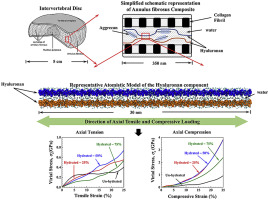Journal of the Mechanical Behavior of Biomedical Materials ( IF 3.3 ) Pub Date : 2020-04-01 , DOI: 10.1016/j.jmbbm.2020.103752 Shambo Bhattacharya 1 , Devendra K Dubey 1

|
Intervertebral Disc (IVD) Degeneration is one of the primary causes of low back pain among the adult population – the most significant cause being the degradation of aggrecan present in the extra-fibrillar matrix (EFM). Aggrecan degradation is closely associated with loss of water content leading to an alteration in the mechanical behaviour of the IVD. The loss in water content has a significant impact on the chemo-mechanical interplay of IVD biochemical constituents at the fundamental level. This work presents a mechanistic understanding of the effect of hydration, closely associated with aggrecan degradation, on the nanoscale mechanical behaviour of the hyaluronan present in the EFM of the Annulus Fibrosus. For this purpose, explicit three-dimensional molecular dynamics analyses of tensile and compressive tests are performed on a representative atomistic model of the hyaluronan present in the EFM. To account for the degradation of aggrecan, hydration levels are varied from 0 to 75% by weight of water. Analyses show that an increase in the hydration levels decreases the elastic modulus of hyaluronan in tension from ~4.6 GPa to ~2.1 GPa. On the other hand, the increase in hydration level increases the elastic moduli in axial compression from ~1.6 GPa in un-hydrated condition to ~6 GPa in 50% hydrated condition. But as the hydration levels increase to 75%, the elastic modulus reduces to ~3.5 GPa signifying a shift in load-bearing characteristic, from the solid hyaluronan component to the fluid component. Furthermore, analyses show a reduction in the intermolecular energy between hyaluronan and water, under axial tensile loading, indicating a nanoscale intermolecular debonding between hyaluronan and water molecules. This is attributed to the ability of hyaluronan to form stabilizing intra-molecular hydrogen bonds between adjacent residues. Compressive loading, on the other hand, causes intensive coiling of hyaluronan molecule, which traps more water through hydrogen bonding and aids in bearing compressive loads. Overall, study shows that hydration level has a strong influence on the atomistic level interactions between hyaluronan molecules and hyaluronan and water molecules in the EFM which influences the nanoscale mechanics of the Annulus Fibrosus.
中文翻译:

聚集蛋白聚糖降解对纤维环原纤维外基质中透明质酸的纳米力学的影响:分子动力学研究。
椎间盘(IVD)变性是成年人口中腰痛的主要原因之一-最主要的原因是原纤维外基质(EFM)中聚集蛋白聚糖的降解。Aggrecan的降解与水分的损失紧密相关,导致IVD的机械性能改变。水分的损失对IVD生化成分的化学-机械相互作用在基本水平上具有重大影响。这项工作提供了一种机械化的理解,即与聚集蛋白聚糖降解密切相关的水合作用对纤维环的EFM中存在的透明质酸的纳米级力学行为的影响。以此目的,对EFM中存在的透明质酸的代表性原子模型进行了拉伸和压缩测试的显式三维分子动力学分析。为了解决聚集蛋白聚糖的降解,水合水平在0至75重量%的水之间变化。分析表明,水合水平的增加使透明质酸在拉伸时的弹性模量从约4.6 GPa降低至约2.1 GPa。另一方面,水合水平的增加使轴向压缩时的弹性模量从未水合条件下的〜1.6 GPa增加到在50%水合条件下的〜6 GPa。但是,随着水合含量增加到75%,弹性模量降低至〜3.5 GPa,表明承载特性从固体透明质酸组分向流体组分转变。此外,分析表明,在轴向拉伸载荷下,透明质酸和水之间的分子间能量减少,表明透明质酸和水分子之间的纳米级分子间解键。这归因于透明质酸在相邻残基之间形成稳定的分子内氢键的能力。另一方面,压缩载荷导致透明质酸分子的强烈盘绕,这会通过氢键捕获更多的水,并有助于承受压缩载荷。总体而言,研究表明,水合水平对EFM中的透明质酸分子与透明质酸分子和水分子之间的原子级相互作用有很大影响,这会影响纤维环的纳米级力学。表明透明质酸和水分子之间的纳米级分子间键合。这归因于透明质酸在相邻残基之间形成稳定的分子内氢键的能力。另一方面,压缩载荷导致透明质酸分子的强烈盘绕,这会通过氢键捕获更多的水,并有助于承受压缩载荷。总体而言,研究表明,水合水平对EFM中的透明质酸分子与透明质酸分子和水分子之间的原子级相互作用有很大影响,这会影响纤维环的纳米级力学。表明透明质酸和水分子之间的纳米级分子间键合。这归因于透明质酸在相邻残基之间形成稳定的分子内氢键的能力。另一方面,压缩载荷导致透明质酸分子的强烈盘绕,其通过氢键捕获更多的水,并有助于承受压缩载荷。总体而言,研究表明,水合水平对EFM中的透明质酸分子与透明质酸分子和水分子之间的原子级相互作用有很大影响,这会影响纤维环的纳米级力学。引起透明质酸分子的强烈卷曲,通过氢键捕获更多的水,并有助于承受压缩载荷。总体而言,研究表明,水合水平对EFM中的透明质酸分子与透明质酸分子和水分子之间的原子级相互作用有很大影响,这会影响纤维环的纳米级力学。引起透明质酸分子的强烈卷曲,通过氢键捕获更多的水,并有助于承受压缩载荷。总体而言,研究表明,水合水平对EFM中的透明质酸分子与透明质酸分子和水分子之间的原子级相互作用有很大影响,这会影响纤维环的纳米级力学。











































 京公网安备 11010802027423号
京公网安备 11010802027423号